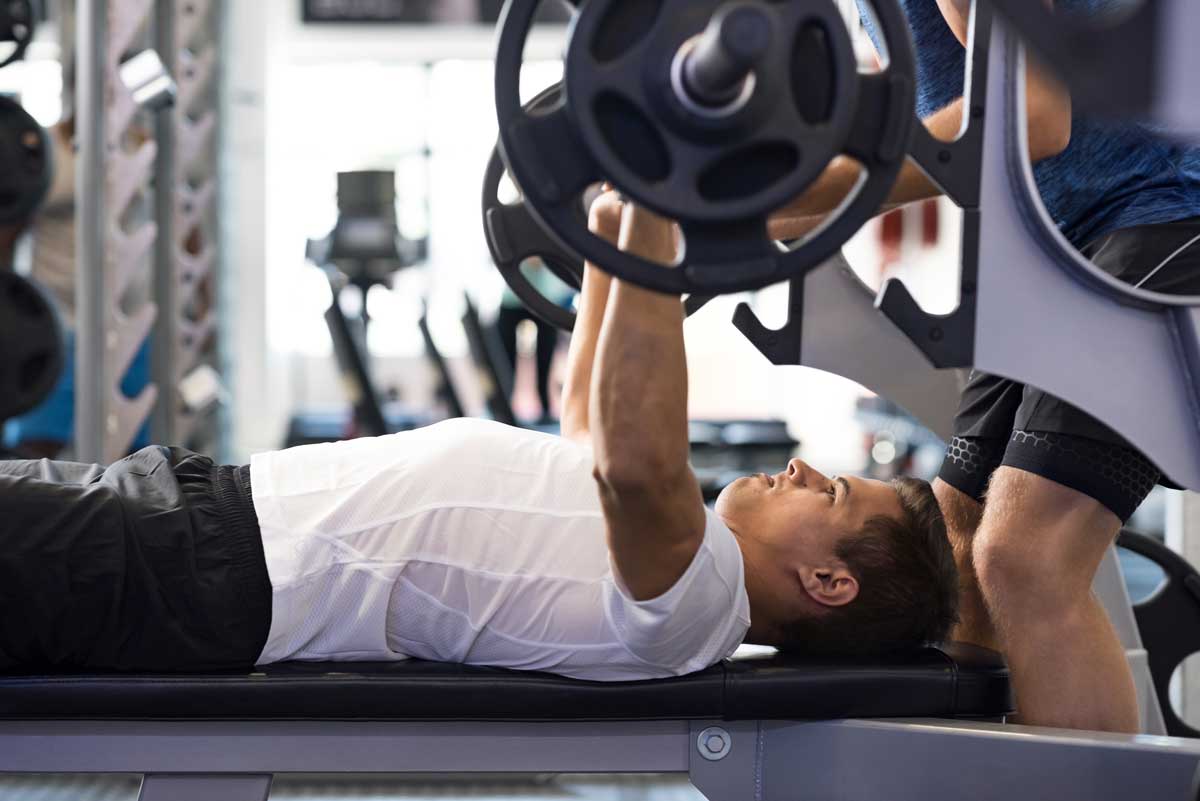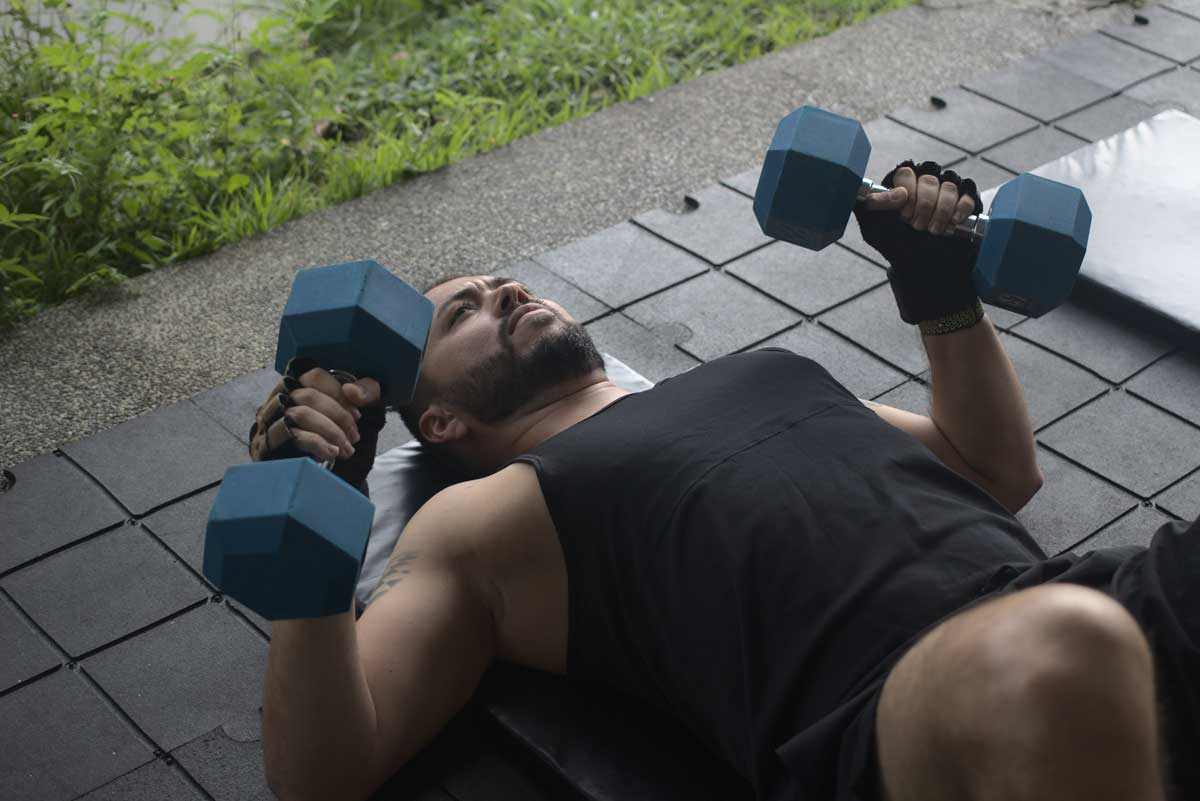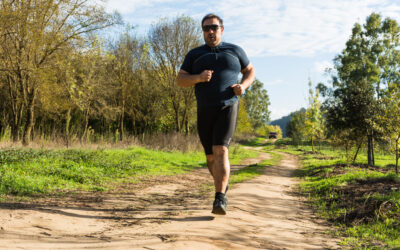Bench Press: To Arch or Not To Arch?
TOPIC: Exercise guides | Strength & Conditioning
Everyone online seems to have a strong opinion about arching your back in the bench press. The reasons and schools of thought vary around the hows/whys, so what’s a novice athlete to do?
Anthony Cuevas, an NCSF Certified PT based out of New York started lifting at 14 years old, so he knows a thing or two about our favorite staple, the bench press. In this piece he talks about bench press mechanics and the differences between holding your back neutral and arching it, along with tips on how to program bench for yourself. Spoiler alert: like most things, it depends on your goals!

Written By
Anthony Cuevas
Anthony Cuevas is an NCSF Certified PT based out of New York with severeal years of experience as a personal trainer.
Arching vs Flat-Back Bench Press
To arch or not to arch? That is the question. It’s a common argument among fitness influencers and strength enthusiasts concerning the bench press. And the answer often depends on personal preference—some choose to lay flat when benching, and some (like myself) choose to arch their backs for leverage.
The bench press is an important and effective exercise regardless of which variation you take, because it works most of your upper body muscles. Emphasis on effectiveness, because that’s what exercises are meant to be at the end of the day, effective.
Different versions of the bench press put emphasis on different parts of your upper trunk. Incline bench works your upper chest, while close grip bench uses more triceps and forearms. But the mechanics behind the standard bench press are worth exploring, especially when it comes to the age-old argument of whether or not to arch your back.
Which bench version is right for you?
It isn’t as one-sided as IG fitness influencers want you to believe. There are actual benefits to both methods of benching.
If your goals are aesthetic, the strict method of benching helps develop your chest more since you’re using a full range of motion (ROM) by stretching the chest muscles at the bottom of the movement and squeezing at the top.
Arching your back in the bench press is commonly used in the powerlifting and weightlifting communities because their goals are more strength-focused. This method of benching helps boost your numbers due to the shorter ROM and leverage of the bar.
I choose to lean more towards the arch due to shoulder injury issues. The shorter range of motion makes the press easier and pain-free. The arch also helps me to be more aware of planting my feet, creating leg drive and spreading my lats on the bench. This added tension uses my whole body to move the bar.
Depending on your personal training goals, experience, and shoulder health, it’s worthwhile to explore both methods.
How to Bench Both Ways
The classic way to bench press for bodybuilders:
Lie flat on the bench and grip the barbell just outside shoulder-width. Keep your shoulders back and chest up with your spine neutral.
Keep your lower back and butt down on the bench with your feet planted to create leg drive. Breathe in as you lower the barbell to your chest and breathe out as you press the bar up.
Using the arch for strength:
Create an arch setup by pressing your shoulders and butt down into the bench and allowing your mid-back to bend, engaging your lats.
Keep your feet planted to create leg drive. Take a breath to brace your core before unracking the bar. The pressing motion is the same: inhale before you lower the bar to tap your chest and exhale as you press the bar up.
Coach’s Tip: Maintaining your lumbar spine’s natural curve is different from arching deeply into your back! With practice, you should be able to feel the difference between the two techniques.

How to Program the Bench Press
I highly recommend programming some form of bench press to develop a strong chest. Here’s an example on how I program my bench press days.
1a. Bench Press
Warmup Sets
Empty bar (45lbs) 2×15
135lbs 1×8
165lbs 2×9
175lbs 2×5
Working Sets
195lbs 3×5
205lbs 4×3
225lbs 3×2
Rest Time
Warmup Sets: 1:00 to 1:30
Working Sets: 1:30 to 4:00
This might seem like a lot of volume for one day, but in order to adapt and make strength gains, I focus on volume one day and technique drills on another day.
The rest period is vital to your success. Don’t skip it! Instead of sitting on the bench looking at social media, I suggest you focus on injury prevention by stretching your upper body muscles during your rest periods. This will help you stay in peak performance while pressing weight.
Bench Press Variations
If you want to truly build those bench numbers in the weight room, you’ll need to add different variations of the bench press using a variety of equipment. Unilateral work (using one arm at a time) helps you focus on creating proper form and addressing imbalances in your barbell bench press.
Here are some common horizontal pressing variations to add to your bench program. Try one of each variation along with your barbell benching to help boost your numbers and grow your chest.
Dumbbells
Flat Bench DB Press
Incline Bench DB Press
Single Arm DB Chest Press
Floor Press
Cables
Cable Chest Press
Seated Cable Chest Press
Single Arm Cable Chest Press
Kettlebells
KB Chest Press
KB Push Ups
KB Floor Press

The final verdict:
Whether or not you choose to arch depends on your own personal goals at the end of the day.
If you’re looking to build an aesthetically pleasing chest—try to bench without arching.
If you’re looking to build compound strength and boost your bench numbers—use the arch.
Whether or not you use the arching method doesn’t need to be some huge argument to determine the right or wrong way to bench press.
It’s mostly a personal choice depending on the goals you’ve set for yourself.
You Work too Hard to Not See Progress
Find Your Perfect Training Plan
Options for Every Goal
Training plans from real coaches covering any goal, fitness level, and number of sessions per week.
The Best Coaches
Get coached by the best. Olympians, ex-NFL stars, Titan Games Winners, Sport Scientists and more.
Starting at $1/ day
With many options including a free 7 day trial, you can try out programming before you commit.
Related Articles
You May Also Like...
How to Do Preacher Curls for Bigger Biceps
Who doesn’t love hitting a good biceps workout and feeling that skin-splitting pump? The preacher curl is a great exercise for bulking up your biceps, but using the EZ bar isn’t the best option for everyone. To build juicy biceps without pissing off your elbow joint,...
Breaking Through the Plateau: Taking Your Weight Loss Journey to the Next Level
You’ve shown up day after day, sweated through workouts, and resisted more cravings than you can count. But the numbers have ground to a stable halt.Hitting a plateau isn’t a failure, it’s proof you’ve been consistent and made real progress. Think of a plateau as your...
A Deep Dive Into the Mind-Muscle Connection
Ever heard of the “mind-muscle connection” and thought, it’s gotta be bogus, right? But some of the top competitive bodybuilders (Arnold included) have used this method in their training and swear by it. Is it real? Are you doing it right? Learn up.Written Byjack shaw...
How to Do Preacher Curls for Bigger Biceps
Who doesn’t love hitting a good biceps workout and feeling that skin-splitting pump? The preacher curl is a great exercise for bulking up your biceps, but using the EZ bar isn’t the best option for everyone. To build juicy biceps without pissing off your elbow joint,...
Breaking Through the Plateau: Taking Your Weight Loss Journey to the Next Level
You’ve shown up day after day, sweated through workouts, and resisted more cravings than you can count. But the numbers have ground to a stable halt.Hitting a plateau isn’t a failure, it’s proof you’ve been consistent and made real progress. Think of a plateau as your...

Want more training content?
Subscribe
For Coaches
For Athletes
About
Support
Training Lab
Access the latest articles, reviews, and case studies from the top strength and conditioning minds in the TH Training Lab!
Made with love, sweat, protein isolate and hard work in Denver, CO
© 2024 TrainHeroic, Inc. All rights reserved.





